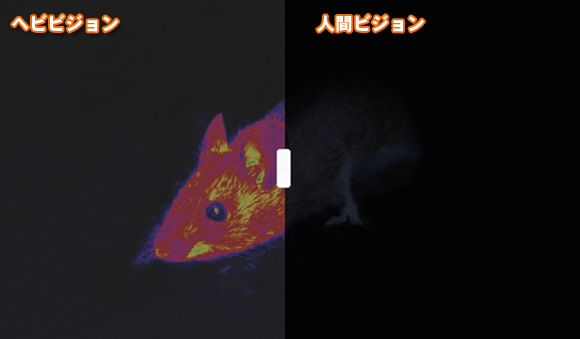Photoreceptor cells
In the outer segment of photoreceptors, light turns into electrical signals.
Expanded rod cell outer segment
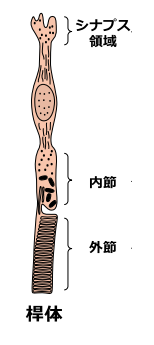

In the outer segment of the pyramidal cell, the cell membrane is invaded many times, and in the outer segment of the rod cell, the invaded membrane is closed, forming a coin-shaped bag (disc) and several hundreds are stacked.
From here, the explanation focuses on rod cells.
State of cells in the outer segment
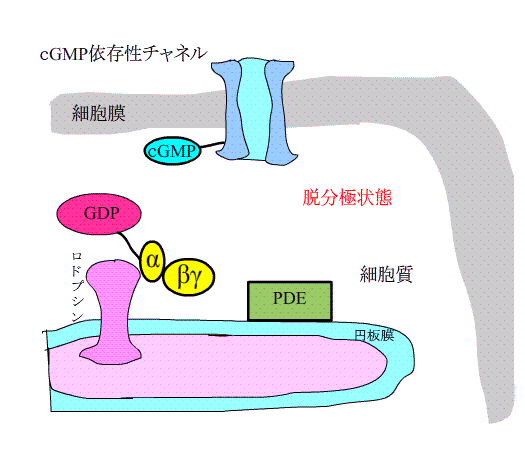
There is a lot of cGMP in the dark, so it acts on the cGMP-dependent channel, which is always open. In other words, Na and Ca enter the cell, and the electric potential of the cell membrane is biased to the plus. Originally, the electric potential inside the cell is quite negative, so this state is seen as polarized. Therefore, this state is called depolarization.
When the outer segment is exposed to light, there is a visual substance that absorbs the energy of light. In the case of rod cells, it is rhodopsin. As in the animation above, when it hits the light, it changes to metalrhodopsin.
Following explanation might be difficult. This causes thebound substance of GDP and α to leave βγ and activate the enzyme PDE.
The enzyme PDE decomposes a substance called cGMP to form 5'-GMP. In other words, cGMP is considerably reduced.
When cGMP is gone, this channel closes because it no longer acts on the cGMP-dependent channel. Na and Ca do not enter the cell. Then, since the number of positive ions decreases, the electric potential inside the cell becomes more biased toward negative. This is called hyperpolarization.
Whether hyperpolarized or depolarized, the action potential at the cell membrane is changing. In other words, it is the moment when the energy of light is converted into action potential. |
What is a visual substance? In the case of rod cells, it is rhodopsin.
This is a combination of retinal (a modified version of vitamin A) and opsin.
Rhodopsin = retinal + opsin
According to the Iwanami Biology Dictionary, rhodopsin is roughly divided into two groups:
Scotopsin, which exists in rod cell and responds to light and dark, and is involved in vision in the dark. Photopsin,which exists in?pyramidal cell and is involved in color vision in the light place
On the other hand, there is a definition that the former is rhodopsin and the latter is photopsin, which seems to be widely adopted, including wikipedia . This is quoted from wikipedia.
When retinal is exposed to light, it causes a structural change and changes in opsin, and it become metalrhodopsin.
This metalrhodopsin quickly becomes inactive and leaves the retinal, becoming opsin. Retinal is not stored in rod cells, and is supplied by pigment epithelial cells. As a result, retinal is not readily available and rod cells take time to restore photosensitivity.。
What is a rod cell? Since it expresses only a single visual substance, it is almost unrelated to color vision on the surface. However, the sensitivity is high, and even in the dark, the shape of the object can be clearly discerned. It also responds to the slightest light. There are about 120 million rod cells in one eye. Rhodopsin decomposes more than 1000 molecules of cAMP in one molecule, so it shows a strong reaction even with slight light. In addition, rod cells that are sensitive to light and dark can feel even one photon, but pyramidical cells that sense color require 100 photons or more, which is insensitive. Even if there are color differences, they cannot be identified. pigmentary degeneration of the retina is a disorder of rod cells that react in the dark. |
Let's see how electrical signals and action potentials from photoreceptor cells are transmitted to ganglion cells.。
It's confusing, so I'll just list the conclusions。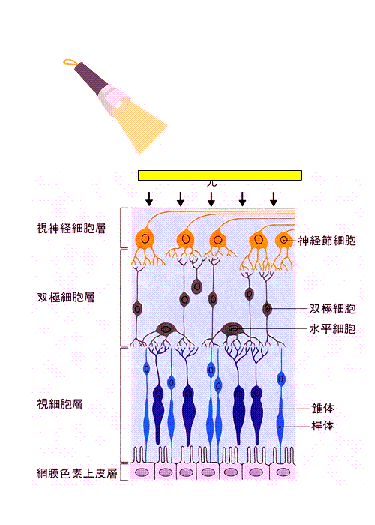
When photoreceptor cells are hyperpolarized, there are two types of bipolar cells: cells that depolarize and cells that hyperpolarize.
Hyperpolarization is a state of inhibition without an action potential, and depolarization is a state of excitation with an action potential. In other words, when the photoreceptor cells are not excited, but the bipolar cells are depolarized, they are excited, and if the bipolar cells are hyperpolarized, they are not excited.。
Bipolar cells receive input from photoreceptors and transmit them to ganglion cells.
There are about 1 million ganglion cells, also called optic nerve cells. It becomes the optic stratum and goes out of the eyeball.
Horizontal cells modify the synaptic transmission between photoreceptors and bipolar cells. It is very complicated. But without these cells, information signals can't be integrated, or organized.
Let's talk about the pyramidal?cell next.
It reacts only when it has a certain level of brightness. It reacts the color along with the light. Pyramidal cells are concentrated in the “macular region”, which is the center of the retina, and there are about 6 million cells in each eye.
It is in the form of photopsin = retinal + opsin , which, like rod cells, has a pigment in the outer segment.
The bound opsins have different amino acid sequences.Tere are three types, blue (absorption peak at 437 nm) , green (533 nm) , red (564 nm).
The color is felt by these three types of pyramidal cells.
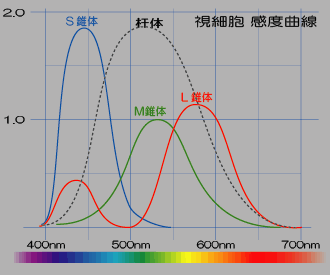
The S pyramidal cells absorbs blue wavelengths, the M conepyramidal cells absorbs green wavelengths, and the L pyramidal cells absorbs red wavelengths.
"You see the color in your brain."
Newton said, "The rays have no color."
These two sentences above mean the same. In other words, color does not exist in the physical environment, and the brain sees the difference in wavelength as color.
For example, if you mix red and green rays to the same extent, you will see yellow. Originally, you did not see the yellow ray, but it was yellow. Looking at yellow means recognizing colors based on the wavelength, and originally there is no yellow. Rays have no color.
By the way, human beings produce various colors in the brain with blue, green, and red light。
The three primary colors of light are deeply related to the way humans perceive color. When light enters the human eye, it forms an image in the most innr retina through the lens, and stimulates photoreceptor cells on the retina. It is a review. There are rod cells that sense brightness and pyramidal cells that sense color. The rod has a very high sensitivity, but it can only judge whether there is light or not. This is good because it is more important to "see" an object in the dark,rather than color information.
On the other hand, pyramidal cells are not so sensitive, but they contain substances that are sensitive to light of red, green, and blue wavelengths , and these functions make it possible to distinguish colors. For example, a substance seen as red changes its structure when it receives red light, and that change is converted into a signal , is transmitted to the brain and we recognizes red.These substances do not react only to specific wavelengths, but as shown in the figure above, they have a certain wavelength as the maximum sensitivity and they have sensitivity in a fairly wide wavelength range .
Therefore, as you can see in the animation above, to the light in the vicinity of yellow, which is between red and green, both the substance recognized red and the substance recognized green react to some extent, and the brain recognizes the yellow color these color mixed. In this way, the three types of substances that sense light in the eye react at various ratios depending on the wavelength of light, enabling the recognition of various colors.
Conversely, even light with a wavelength is not there, it can be made as if a color with that wavelength exists by combining red, green, and blue. For example, if you don't actually catch the yellow light, but you put red and green light into your eyes at the same time, your brain will recognize the yellow light. In other words, since the human eye is made to recognize the difference in wavelength (as a difference in color) by the combination of red, green, and blue. It can be used in reverse, and it is possible to create most of color by combining three types of light, red, green and blue. This is the origin of the three primary colors of light.
So, if humans had substances that were sensitive to different wavelengths, the three primary colors of light would have been different. For example, people with "color blindness"is differet only in the composition of substances that respond to color, and they have thier own primary colors. There is no problem as long as they have different 3 primary colors, or 2 primary colors even if they are not Red, green,and blue.
Look closely at the above figure, and do you notice anything strange?
A substance recognized as red has a little sensitivity in the blue region. What does this mean? Actually, this is effective when light with a wavelength shorter than that of blue comes in. If a substance that reacts red had sensitivity only in the long wavelength region, light with a shorter wavelength than blue would be simply perceived as pale blue. However, substances that reacts red also gets active, and their sensitivity is high even at short wavelengths, so the brain can recognize reddish blue, that is, purple. In this way, light with a shorter wavelength than blue can be properly recognized and distinguished from blue. It is the reason that a slightly reddish "purple" is seen outside blue in the rainbow.
The three primary colors of light are actually the light of the color (in each wavelength), so if you mix them, it will become brighter, and if you mix all three colors at the same ratio, it will become white (W) Strictly speaking, the color is not "white", but the brightness is saturated.
Next we talk about the three primary colors like paint.
 The three primary colors become dark when mixed, and finally become black (Bk) (subtractive color mixture). Why would this happen?
The three primary colors become dark when mixed, and finally become black (Bk) (subtractive color mixture). Why would this happen?
That's because the three primary colors are for the colors of materials, not light. Since ordinary objects do not emit light by themselves, they appear by reflecting light from the outside. The color of the object appears by absorbing a specific wavelength from the white light containing all the components and reflecting the rest.
Look at the anime above again. For example, magenta (M) in the figure on the left appears where red (R) and blue (B) are mixed, but if you change the viewpoint, it can be thought it exclude only green (G) from white (W) where all colors are mixed. In other words, a magenta object looks as magenta (M) because it absorbs only green (G) component of white light and reflects the rest. Similarly, cyan (C) is shown by refrection except red (R), and yellow (Y) is shown by refrection except blue (B). In this way, each three primary colors are shown by the mixture of all the colors except each one of the three primary colors of light.The relationship such as red (R)- cyan (C), green (G)-magenta (M), blue (B)-yellow (Y) is called "complementary color". For this reason, for example, when mixing paints, each time they are mixed, the amount of absorbed components increases, and eventually it becomes black (Bk).
Please think carefully.
Let't consider the color vision of other organisms.
Most organisms in fish , amphibians , reptiles , and birds have four types of pramidal cells (tetrachromacy ). It is thought that these organisms can recognize from the long wavelength region to the short wavelength region, ultraviolet rays.
On the other hand, most mammals other than primates have only two types of pyramidal cells (dichromatism ). Reptiles , mammalian ancestors, had all four types of pyramidal cells, but for mammalian it seems that color vision was not essential for survival , as early mammals were predominantly nocturnal . As a result, we lost 2 out of 4 types of pyramidal cells.Speaking about the primates in the Old World ( Catarrhini ) including Homo sapiensis, the female came to have a 3-color type color vision(trichromatopsia), then the male also got the vision about 30 million years ago.This is the “regenerated” third pyramidal cell (green). The three-color type color vision (trichromatopsia)seemed to be useful for finding red fruits ( rich in vitamin C and sugars) in the green leaves.
In humans, the retina recognizes the three types of light “red, green, and blue” called trichromatopsia, but in other animals, it is greatly affected by the ecological environment such as two-color type ( dichromatism )and four-color type(tetrachromacy).
Cat
Since they have a two-color type of color vision (dichromatism), their view is seem to be similar to that of person with color blind. Also, their resolution is low, so they see about 6 times as blurry as humanin the bright, but they can clearly see in the dark.
The vision of cat is left ,and the vision of human is right

Bee
They have a three-color type of color vision (trichromatopsia) like human. However the type of light human have is "red, green, and blue" whereas that bee have is "yellow, blue, and ultraviolet." By recognizing ultraviolet rays, the color of the petals containing plenty of nectar,which is their feed, can be distinguished more clearly.
The vision of bee is left ,and the vision of human is right

Bird
It is said that they have better eyes than human. Many birds have a four-color type color vision(tetrachromacy) in which "ultraviolet rays" are added to "red, green, blue". Also, some raptores have 2.5 times the resolution of humans, and they can see far clearly. Pigeons are said to detect colors better than any other animal on earth.
The vision of bird is left ,and the vision of human is right

Viper such as rattlesnake
They can recognize infrared rays. The "pit organ" between the eyes and mouth senses infrared rays.They can accurately catch the position of the prey by integrating the infrared information obtained from this organ and the visual information obtained from the eyes.Therefore, even if they can hardly see in the daytime, they can clearly see at night, and they are like the strongest warrior with night vision.
The vision of viper is left ,and the vision of human is right
